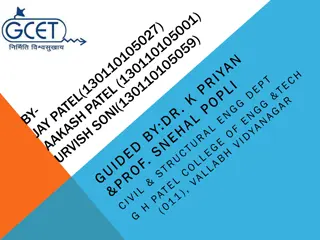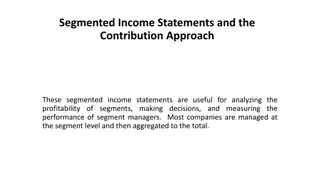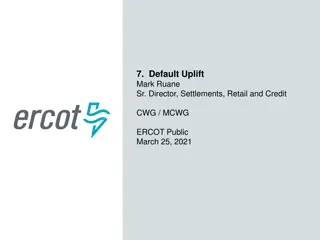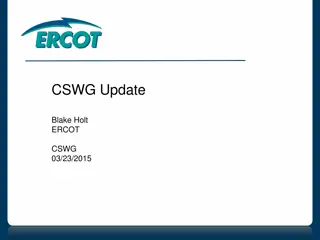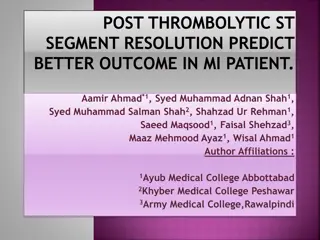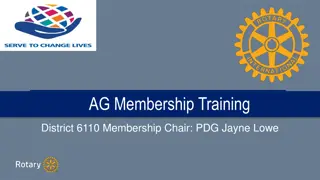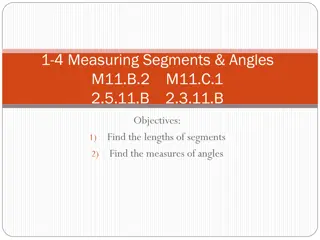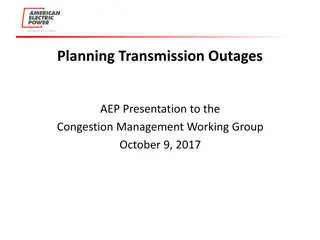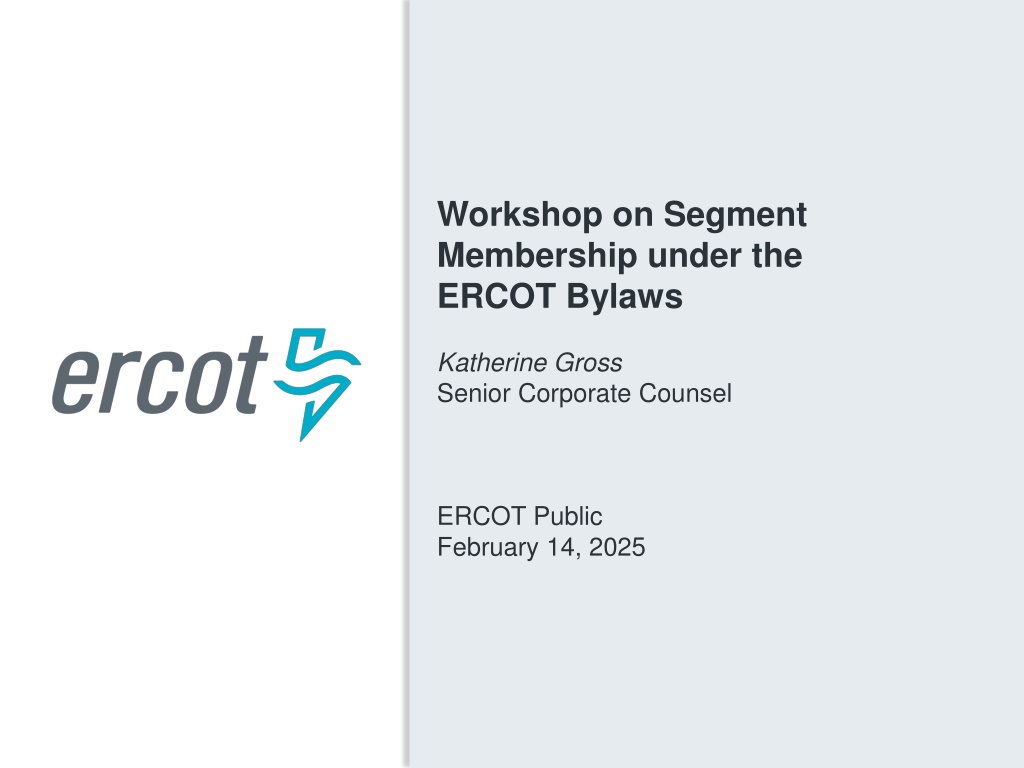
Workshop on Segment Membership under the ERCOT Bylaws
Explore data on the changing membership within different segments under the ERCOT Bylaws since 2014, highlighting the growth, composition, and key takeaways. Discover the trends in membership numbers and percentages for various categories, including Industrial Consumers, Investor-Owned Utilities, Independent Generators, and more.
Download Presentation

Please find below an Image/Link to download the presentation.
The content on the website is provided AS IS for your information and personal use only. It may not be sold, licensed, or shared on other websites without obtaining consent from the author. If you encounter any issues during the download, it is possible that the publisher has removed the file from their server.
You are allowed to download the files provided on this website for personal or commercial use, subject to the condition that they are used lawfully. All files are the property of their respective owners.
The content on the website is provided AS IS for your information and personal use only. It may not be sold, licensed, or shared on other websites without obtaining consent from the author.
E N D
Presentation Transcript
Workshop on Segment Membership under the ERCOT Bylaws Katherine Gross Senior Corporate Counsel ERCOT Public February 14, 2025
Data on Change in Membership since 2014; Overall Number of Members 30 Total Number of Members 2014 2015 2016 2017 2018 2019 2020 2021 2022 2023 2024 2025 281 276 271 285 282 257 262 239 275 279 333 319 Corporate* 28 24 26 24 17 19 19 17 18 18 21 19 Associate - - - - - - - 1 - 1 2 - Adjunct Total 309 300 297 309 299 276 281 257 293 298 356 338* *Includes OPUC and TAC Residential; data for all slides taken as of January 9, 2025 Key Takeaway: 2024 was the highest membership year to date. 3 ERCOT Public
Data on Change in Membership since 2014; Number of Members in each Segment 2014 2025 Segment No. of Members (309 total*) 23 10 25 27 19 40 16 67 80 2 Percentage Share Membership Changes (338 total*) +10 n/a -3 -15 -2 -1 +17 +16 +7 n/a Percentage Share 7% 3% 8% 9% 6% 13% 5% 22% 26% 1% 10% 3% 6% 3% 5% 12% 10% 24% 26% 1% Independent Generators Investor-Owned Utilities Power Marketers Retail Electric Providers MOUs Electric Cooperatives Industrial Consumer Large Commercial Consumer Small Commercial Consumer Residential Consumer *Totals include Corporate, Associate, and Adjunct Members 4 ERCOT Public
Data on Change in Membership 2024 - 2025; Number of Members in each Segment 2024 2025 Segment No. of Members (356 total*) 39 10 23 14 17 43 31 80 97 2 Percentage Share Membership Changes (338 total*) -6 n/a -1 -2 n/a -4 +2 +3 -10 n/a Percentage Share 11% 3% 6% 4% 5% 12% 9% 22.5% 27% 0.5% 10% 3% 6% 3% 5% 12% 10% 24% 26% 1% Independent Generators Investor-Owned Utilities Power Marketers Retail Electric Providers MOUs Electric Cooperatives Industrial Consumer Large Commercial Consumer Small Commercial Consumer Residential Consumer *Totals include Corporate, Associate, and Segment-assigned Adjunct Members. 5 ERCOT Public
Data on Change in Industrial Consumer Segment since 2014; Composition 2014 Today 0 12 (36% of the 2025 Industrial Consumer Segment) Number of Cryptocurrency Centers or Data Centers 6 ERCOT Public
ERCOT 2025 Membership Fees Associate & Adjunct Members Fees for Small & Large Consumers* Fee for Gov. Member Corporate Member OPUC does not pay a fee $100 (Corporate) $50 (Associate) $2,000 $500 *since 2006 Key Takeaway: ERCOT Membership fees have been consistent since at least 2000. 7 ERCOT Public
ERCOT 2025 Membership Benefits Dues provide Members with rights pursuant to the ERCOT Bylaws (voting) Entitle Members to services ERCOT provides "such as hosting ERCOT meetings, providing Members with necessary information, and such other Member services as ERCOT may from time-to-time offer." ERCOT Membership Agreement, at 1 8 ERCOT Public
ISO/RTO Comparisons At the November 20, 2024 TAC meeting, stakeholders requested data on other ISOs' annual Membership fees and voting structures. The following slides are ERCOT's understanding of other ISO's fees and voting structure but may have inaccuracies. Additionally, some points have been simplified for easier comparison. Interested persons should seek out more information directly from the ISO on which they have questions. 9 ERCOT Public
ISO/RTO Comparison of 2025 Membership Fees "Typical" Voting Fee for Business Entity Fee for Enironmental Parties/Small Consumers Fee for Gov. Member ISO/RTO CAISO has no stakeholder voting, so N/A N/A N/A CAISO* Generally, $5,000 ("end-users" start at $500, but goes up based on usage) $500 (if choose to vote) (see prior cell on "end-users") ISO-NE $1,000 $0 $0 MISO $5,000 $100 $0 NYISO* $500 for Consumer Advocate offices; $0 for Environmental; $0 for small consumer individual $5,000 $0 PJM $6,000 N/A N/A SPP* *Didn't hear back from ISO for confirmation 10 ERCOT Public
CAISO Voting Unlike other ISOs/RTOs, CAISO does not have a committee structure for consideration of issues and changes to market rules. Other ISOs/RTOs also have stakeholder voting schemes, so that stakeholders can weigh in on proposed market rule changes (although such votes are not necessarily binding). CAISO has no stakeholder voting. Instead, CAISO opens stakeholder initiatives on a range of market-related and transmission-related issues and policy initiatives and schedules regular meetings to discuss those initiatives. These meetings are open to the public, although some documents may be confidential for security or legal reasons, and follow the CAISO Open Meeting Policy governing quorums, notices, agendas, allowance for recording by audio and video, and other topics. One example of a relevant provision in the Open Meeting Policy is that if the Board votes to recess an open meeting to another time and place, the reconvened meeting can only conduct the business previously noticed for the recessed meeting. The overall goal of the Open Meeting Policy is to afford[] the public the greatest possible access consistent with other duties of the corporation and the Policy is designed to be compliant with State of California open meeting laws. (Emphasis added.) Source: Understanding and Participating in California ISO (CAISO) Processes | Federal Energy Regulatory Commission 11 ERCOT Public
ISO New England Voting NEPOOL is the New England Power Pool, a voluntary association of market participants from the six New England states, organized under and governed by the Second Restated NEPOOL Agreement The NEPOOL website provides additional information NEPOOL members representatives form the Participants Committee (PC) the primary stakeholder advisory body to ISO New England For voting purposes, NEPOOL participants are divided into the following: the Generation Sector, the Transmission Sector, the Supplier Sector, the Alternative Resources Sector, the Publicly Owned Entity Sector, and the End User Sector Members select their sector during the application process; sector designations are finalized by NEPOOL at the Membership Subcommittee meeting when the application is reviewed Source: ISO NE Participants Committee 12 ERCOT Public
MISO Voting (Advisory Committee) Assigned Seat and Vote Sector Source: MISO Stakeholder Governance Guide, at page 9 13 ERCOT Public
MISO Voting (Planning Advisory Committee) Source: MISO Stakeholder Governance Guide, at pg. 9 14 ERCOT Public
NY-ISO Voting Source: NYISO Governance: FAQs 15 ERCOT Public
PJM Voting "For purposes of voting in the Senior Standing Committees, the PJM Members are divided into five sectors: Generation Owners, Other Suppliers, Transmission Owners, Electric Distributors, and End-Use Customers, and a process called sector-weighted voting is used ... In sector-weighted voting, each of the five sectors contributes to 20% of the overall vote." Source: An Introductory Guide for Participation in PJM Processes | Federal Energy Regulatory Commission Source: PJM Governance and Membership Structure 16 ERCOT Public
SPP Voting "The top-level stakeholder committee is called the Markets and Operations Policy Committee, or MOPC (pronounced MOP-see ). Each SPP member appoints a representative to the MOPC. For purposes of voting in the MOPC, there are only two sectors: Transmission-Owning and Transmission Using, giving each of these sectors essentially equal power. Each member votes within their sector, and then a weighted average of the two sectors is calculated. The weighted average must be 66% for a proposal to pass in the MOPC." "There are also technical committees or working groups to consider issues before they reach the MOPC, which in SPP are called Organizational Groups. The Working Groups and Advisory Groups shown above are examples of SPP Organizational Groups. Organizational Group representation is typically appointed by the SPP Board, who considers the various types and expertise of members and their geographic locations to achieve a widespread and effective representation of the membership in the Organizational Group. Each Organizational Group may in turn appoint task forces to consider an issue. Voting in the Organizational Group or a task force thereof is by simple majority of participants. Key Organizational Groups include the Economic Studies Working Group, Market Working Group, and Transmission Working Group. (Emphasis added.) Source: An Introductory Guide for Participation in Southwest Power Pool Processes | Federal Energy Regulatory Commission 17 ERCOT Public
Process to Amend Bylaws Approving / Acting Entity ERCOT Director; ERCOT Secretary; Corporate Member(s); TAC; or HR&G Committee Bylaws Amendment Process Steps Authority Bylaws 13.1 TAC Proc. I.A HR&G Charter IV.B.1.a Initial proposal of Bylaws amendment HR&G Charter IV.B.1.a, V.A, V.B HR&G Committee Initial HR&G Committee meeting and discussion Corporate Members Bylaws 13.1 21-day notice and comment period for Corporate Members PUCT PURA 39.151(g-1) PUCT Statement of Input HR&G Committee HR&G Charter IV.B.1.a Final HR&G Committee Meeting and Recommendation to Board Board Bylaws 13.1 Final Board approval Filing of ERCOT-approved Bylaws amendment at the PUCT for approval PUCT PURA 39.151(g-1) PURA 39.151(g-1), 39.1514 Bylaws amendment effective upon PUCT approval by order 18 ERCOT Public
Remaining Agenda The following proposals will be covered for the remaining agenda: Texas Industrial Energy Consumers (TIEC), ERCOT Steel Mills, and the Texas Block Chain Council joint proposal to address issues related to the Industrial Consumer Segment Enchanted Rock proposes the creation of a DG Segment within ERCOT s stakeholder structure by reallocating one of the four votes from the Independent Generator Segment at TAC Vistra proposes separate Member segments for Thermal and Inverter-Based Generators NextEra proposal regarding "Affiliate" definition in the Bylaws 20 ERCOT Public
Appendix Sources for Fees in other ISOs: ISO NE: FAQs: Membership NY-ISO: 471f13a1-5def-7358-b0a5-42221906ac0e PJM: PJM - Membership Enrollment MISO: Non-Transmission Owners Membership Application92000.pdf and Transmission Owners Membership Application92001.pdf SPP:SOUTHWEST POWER POOL, INC In addition, ERCOT coordinated with some ISOs to better understand their fee (and voting structure), which resulted in additional information in some cases than what was listed in the above sources. 21 ERCOT Public

